 Are Clothes Modern? (1946)
Are Clothes Modern? (1946)
 Are Clothes Modern? (1946)
Are Clothes Modern? (1946)
Clothing is the our brightest mirror, its form dictated by politics, regionalism, mores, and sometimes the human form. It's a thorough celebration of frivolous sentimentality, 1950's spandex predictions of the future rebuffed by garments that are still impractical, irrational, under the shadow of 18th century aristocratic dress and vestigial boutonnières. It's why American WWI-era Navy pants had a 13-button fly or why italian penises siloutted between hose is indecent but a fabric codpiece accentuating it isn't. English smocks or Inuit parkas evolving from workwear to elaborately embroidered formalwear speaks to a universal, irrational desire that goes beyond pumping out a dozen kids and dying of a waterborne disease. What does modern clothing reflect about us today?
 Mirror, Mirror: A Social History of Fashion (1977)
Mirror, Mirror: A Social History of Fashion (1977)
 Mirror, Mirror: A Social History of Fashion (1977)
Mirror, Mirror: A Social History of Fashion (1977)
Under colonization people needed to be transformed, to speak like us, pray like us, dress like us, fuck like us. And with it clothing lay in a sort of ambivalence among early writers. Sacralizing the variety and practicality of national dress, eternalizing it in writing yet working to destroy its reiteration. Colonization and the mutually developed field of anthropology would carry these sentiments into the 1970s, academic journals unironically headlined with phrases like "civilizing dress."
 Are Clothes Modern? (1946)
Are Clothes Modern? (1946)
 The Book of Costume: Or, Annals of Fashion (1846)
The Book of Costume: Or, Annals of Fashion (1846)
A couple centuries later the post-WWII surplus in the US gave birth to a host of nightmares like food suspended in jello and TV dinners. In clothing it was to a degree where anglo preoccupations of class gave way to cheap clothing. Performative dress gave way to a democratized but increasingly hegemonic style - wool suits were traded for t-shirts (originally popularized as a US Navy undergarment). And this process of de-sacralizing clothing continued with globalization, stripping away hats and jackets from the collective expectation on how one should dress. Americans started to embrace classless dress as its own uniform, rejecting aspirational WASPyness and the rigid formalities of Europe.
After World War II the mass clothing industry so perfected its techniques, especially in the United States, that poverty began to disappear visually, if not in fact. When a boy's shirt, tolerably well made, could be bought for the price of three loaves of bread and the price of soap fell, it followed that rags and filth became the property of the inebriate or the deranged. Moreover, when factories provided lockers for their employees, work clothes were no longer seen on the streets of major cities. As a result, a presentable or possibly even stylish dress or suit might easily cover an empty stomach. In the words of Michael Harrington, "It almost seems as if the affluent society has given out costumes to the poor so that they would not offend the rest of society with the sight of rags." Democratization was such that it impressed even the Soviet Premier, Nikita Khrushchev. On meeting Nelson Rockefeller, he noted with some amazement: "The biggest capitalist in the world wasn't dressed in cheap clothes, but I wouldn't say he was dressed elegantly either. He was dressed more or less like other Americans."
And with this gradual transition new expectations of dress emerged, not one centered around performative class but its thorough rejection. Today in the US deviating from acceptable dress seen as pretentious, unneeded peacocking. Rarity and formality are almost interchangable, Wingtip oxfords might as well be opera pumps in how they're seen by sweatpants-wearing members of the public. This flavor of class-conscious fashion collectivism in a country well-known for its individualistic ethos is somehow more prominent than Eastern cultures defined by the mountainous, insular, feudal village. It echoes timeless sumptary laws barring tyrian purple or exaggerated fashions, something usually a reiteration of emperors and kings' legitimacy over the castle corner shitting aristocracy.
 Are Clothes Modern? (1946)
Are Clothes Modern? (1946)
Workwear around 2010 championed ethical consumption: Know where your garment was sewn, where the fabric was milled, where the staples were grown. Takehiro was a NEET for 3 years after college, loves fishing by Enoshima, cheats on his wife of 8 years on the weekends, and sews your jeans in Okayama. But while transparency produces enough bravery to drop triple digits on clothing, it doesn't tackle the underlying issue: is an informed consumer in the US buying garments shipped from Japan made by Egyptian textiles an ethical consumer?
Inmates at the Eastern Oregon Correctional Institute produce denim clothing to both supply its internal needs, and to sell online. The jeans and coats are distributed on a prehistoric website with the same dry, burecreatic, almost sanitory language like a DMV form. The phrases "reducing taxpayer costs" and "paying for their own incarceration costs" belt-tightening attitude now sits uncomfortably alongside facts about venal judges shuttling people towards for-profit prisons. As it so happens, the 1682-bed prison is the city of Pendleton´s fourth largest employer. For-profit prison being the most depressing word salad since "silicone woman" or "reddit poweruser."

The website doesn't mention inmates are paid around $4 to 5 dollars a day for their work, much less that this is a desirable job within the prison. It isn't hard to see why considering the alternatives. Penal labor is an enduring institution in the US`. Your favorite companies have taken advantage of prisoners being paid decimaled wages, even through an ongoing pandemic. Prison Blues presented a dilemma to many workwear adherents. Legitimacy is one of the draws of workwear, and here was a source of US-made denim garments at inordinately inexpensive prices. Some forum users, no doubt acclimated to spending many times that on their superficial hobby, decried what ideologically violated a genre that championed union labor. Others didn't care.
 Are Clothes Modern? (1946)
Are Clothes Modern? (1946)
The arrangement is to be expected as an essential commodity, one that bumps shoulders with food and water. And perhaps my sacralization of plant corpses that we hang off our bodies is an overreaction. But while mainstream attention on sustainability and ethical consumption have passed over food in the 2000's, it lies latent within the world of clothing. Every few months there's a horrendous stream of news coming from Asia strewn across your screen like terrible little croutons. Multinationals point fingers at other competitors' sweatshops and shrug. The system is terrible, but to an acceptable degree.
ε=ε=(っ* ´□` )っ back to top ⤴
 I sew my own clothes. It's fun. I initially started to save money, unwilling to spend hundreds on artifical scarcity when the clothing looked like something I could make. And so I did, starting around 2015. It's a cheap hobby when two meters of cloth for $10 translates into a shirt. The process of drafting, cutting, hemming, and sewing also opens your eyes to how mind-manglingly underpaid garment workers are, crafting up incredibly complex clothing for $3 an hour. Upcycling from used clothes is an option if fabric is expensive where you live, breathing new life in something otherwise destined to decorate an andean mountainside.
I sew my own clothes. It's fun. I initially started to save money, unwilling to spend hundreds on artifical scarcity when the clothing looked like something I could make. And so I did, starting around 2015. It's a cheap hobby when two meters of cloth for $10 translates into a shirt. The process of drafting, cutting, hemming, and sewing also opens your eyes to how mind-manglingly underpaid garment workers are, crafting up incredibly complex clothing for $3 an hour. Upcycling from used clothes is an option if fabric is expensive where you live, breathing new life in something otherwise destined to decorate an andean mountainside.
Sewing also makes you reconcile with your bad habits. I'm rather impatient when it comes to the stream of gratification from hobbies. Sewing made me slow down, plan, and improvise. It's by far my most steady and enduring source of hard work that always pays off. It's also made me comfortable with imperfections. A loose stitch there or an occasional crooked joint doesn't bother me: I'm at a good place when I'm much less critical of my own work. When making a small mistake you have to press on and fix it later. Afterwards you're so happy with the result that these small flaws don't matter.
It's reassuring to have a hobby with a continually morphing "end." Usually interest is extinguished once a particular something is in your hands within an acceptable budget, whether it's watches, pens, cameras, etc. For clothing your tastes and standards change constantly, there is no singular goal. Even if you have one specific outfit to work towards, wearing clothes is a daily mix and match, there's so many elements to one outfit. And so an "endgame" garment isn't really the center of focus becuase wearing the same thing everyday isn't fun.
I'm also firesafe. If I ever burst into flame the RNs won't have to debride the molten nylon off my goopy medium rare flesh.

 Hanten Linen shirt 8 oz 44/45 linen rayon・$20・12 hours of work・My first "real" sewing project. Wanted to put an emphasis on an open neck/collarline and overlapping body. Front closure is done via two ties. Neckline and edge finishing was a bit maddening. Patterning was fun, but I would've used heavier cloth to test. Overall, my most refined piece of clothing. 4/16/19: Added a button so the neckline is a bit higher.
Hanten Linen shirt 8 oz 44/45 linen rayon・$20・12 hours of work・My first "real" sewing project. Wanted to put an emphasis on an open neck/collarline and overlapping body. Front closure is done via two ties. Neckline and edge finishing was a bit maddening. Patterning was fun, but I would've used heavier cloth to test. Overall, my most refined piece of clothing. 4/16/19: Added a button so the neckline is a bit higher.

 British DPM Lightweight Combat Shirt, dyed $7・4 hours of work・I already owned an overdyed jacket, but the symmetrical pockets popped into my head as an idea. Actual cost was $3 after using an ebay code, rest was the cost of the dye. Seeingly simple but fuck me dead are gussetted pockets a pain to sew. Dyed black over 2ish hours, I expect it to turn navy as I wear it more. There's a famous photo of British troops in Afghanistan who dyed their desert DPM green, coming out a grotesque shade of turqoise. Overall, a versatile jacket that I wear very often.
British DPM Lightweight Combat Shirt, dyed $7・4 hours of work・I already owned an overdyed jacket, but the symmetrical pockets popped into my head as an idea. Actual cost was $3 after using an ebay code, rest was the cost of the dye. Seeingly simple but fuck me dead are gussetted pockets a pain to sew. Dyed black over 2ish hours, I expect it to turn navy as I wear it more. There's a famous photo of British troops in Afghanistan who dyed their desert DPM green, coming out a grotesque shade of turqoise. Overall, a versatile jacket that I wear very often.
 Wrangler 126MJ modified original$30・4 hours・Overdyed indigo, modified mandarin collar
Wrangler 126MJ modified original$30・4 hours・Overdyed indigo, modified mandarin collar

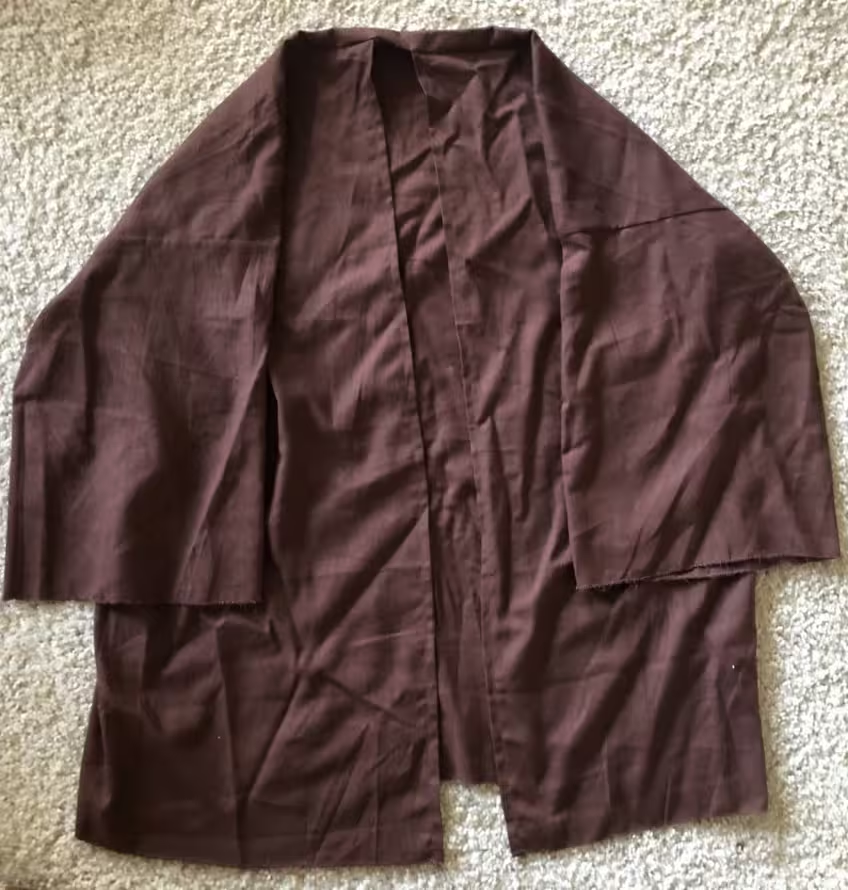 Hanten Linen Jacket 6oz・55/45 linen rayon・This one was rather quick, opting for another pattern that avoided sewing the length of the body and simplified neckline. Drapes well, but I neglected to take out the selvedge on the hem which bugs me. I also need to add pockets and a front closure to make things a bit easier.
Hanten Linen Jacket 6oz・55/45 linen rayon・This one was rather quick, opting for another pattern that avoided sewing the length of the body and simplified neckline. Drapes well, but I neglected to take out the selvedge on the hem which bugs me. I also need to add pockets and a front closure to make things a bit easier.
 Pleated Hanten shirt 6oz 100% linen・$15・8 hours of work・Really wanted to make another shirt but I've already made a white hanten. Used the same pattern from the brown hanten, simplifies the neckline significantly. Decided to add some pleating to add some folds and looseness. Back is gusseted, front has maetate. looks like shit on a hanger, but I love it when I wear it. Need to think of a closure for this too. Edit 2020: scrapped for fabric. farewell.
Pleated Hanten shirt 6oz 100% linen・$15・8 hours of work・Really wanted to make another shirt but I've already made a white hanten. Used the same pattern from the brown hanten, simplifies the neckline significantly. Decided to add some pleating to add some folds and looseness. Back is gusseted, front has maetate. looks like shit on a hanger, but I love it when I wear it. Need to think of a closure for this too. Edit 2020: scrapped for fabric. farewell.
 Mountain Troops Anorak 10oz upholstery linen・$20・~30 hours of work・Loosely modelled after the WWII Gebirgsjägers anorak. It's thick upholstery fabric that I was planning to dye black. I quite like the arctic splinter camo vibes. I was expecting it to shrink during dyeing so I had to redo the pattern. If It came out too dark I was planning to wax it like a Barbour jacket. First time dealing with a hood so there were many mental gymnastics in order to visualize the final product. The rat tail on the back is a crotch strap to prevent the whole thing from hiking up during wind. There were also two ass pockets on the original, but I decided to omit them as they were in an odd spot. My copy is cut a bit shorter than the original. Edit 4/17/2019: Sewed on the buttons finally, really like how It came out.
Mountain Troops Anorak 10oz upholstery linen・$20・~30 hours of work・Loosely modelled after the WWII Gebirgsjägers anorak. It's thick upholstery fabric that I was planning to dye black. I quite like the arctic splinter camo vibes. I was expecting it to shrink during dyeing so I had to redo the pattern. If It came out too dark I was planning to wax it like a Barbour jacket. First time dealing with a hood so there were many mental gymnastics in order to visualize the final product. The rat tail on the back is a crotch strap to prevent the whole thing from hiking up during wind. There were also two ass pockets on the original, but I decided to omit them as they were in an odd spot. My copy is cut a bit shorter than the original. Edit 4/17/2019: Sewed on the buttons finally, really like how It came out.
 Wool Hanten 11oz wool・$5・15 hours of work・Started and finished this on the same day I got my full-sized sewing machine. A tad larger than the brown linen hanten with a different front closure. I really like it! Perfect for winter, oversized for plenty of layers, just pair it with some wide pants and you're set. My only concern is piling, a downside for using cloth as soft as this as outerwear.
Wool Hanten 11oz wool・$5・15 hours of work・Started and finished this on the same day I got my full-sized sewing machine. A tad larger than the brown linen hanten with a different front closure. I really like it! Perfect for winter, oversized for plenty of layers, just pair it with some wide pants and you're set. My only concern is piling, a downside for using cloth as soft as this as outerwear.
 igiboso 6oz cotton・$5・5 hours of work/Loosely based on Igiboso worn by buddhist pure land priests. Has an internal pocket and lanyard for keys. I use this thing all the time, especially useful on pants without ass pockets.
igiboso 6oz cotton・$5・5 hours of work/Loosely based on Igiboso worn by buddhist pure land priests. Has an internal pocket and lanyard for keys. I use this thing all the time, especially useful on pants without ass pockets.
 brown 2 12oz 45/55 linen cotton・$8・19 hours of work/Another one of these. I'm not a terribly big fan of the wrinkled cheap kimono-esque texture that this fabric retains, completely different from typical linen wrinkles. Actually learned a lot this time, Played around with vertical pleats but the silouette came out narrow and nasty. Turns out a short neckline is essential for the drapy figure I'm after.
brown 2 12oz 45/55 linen cotton・$8・19 hours of work/Another one of these. I'm not a terribly big fan of the wrinkled cheap kimono-esque texture that this fabric retains, completely different from typical linen wrinkles. Actually learned a lot this time, Played around with vertical pleats but the silouette came out narrow and nasty. Turns out a short neckline is essential for the drapy figure I'm after. Still figuring out the front closure and sleeves 8/7/2020 Added a front closure and finished the sleeves. I wear this thing out constantly. 11/17/2020
 cargo pants 8oz cotton・$3・10 hours of work・Still working on the Fly
cargo pants 8oz cotton・$3・10 hours of work・Still working on the Fly, waistline, and hem. Gusseted pockets are hard but satisfying. 9/3/2020 Finished, deciding whether to add normal slit pockets. Waiting on some mordant to dye this with red onion skins. 12/12/2020
 splinter hanten 12oz upholstery linen・$20・10 hours of work・another one of these, using the same fabric for the mountain troops anorak. need of a front closure or maybe pockets 9/23/2020
splinter hanten 12oz upholstery linen・$20・10 hours of work・another one of these, using the same fabric for the mountain troops anorak. need of a front closure or maybe pockets 9/23/2020
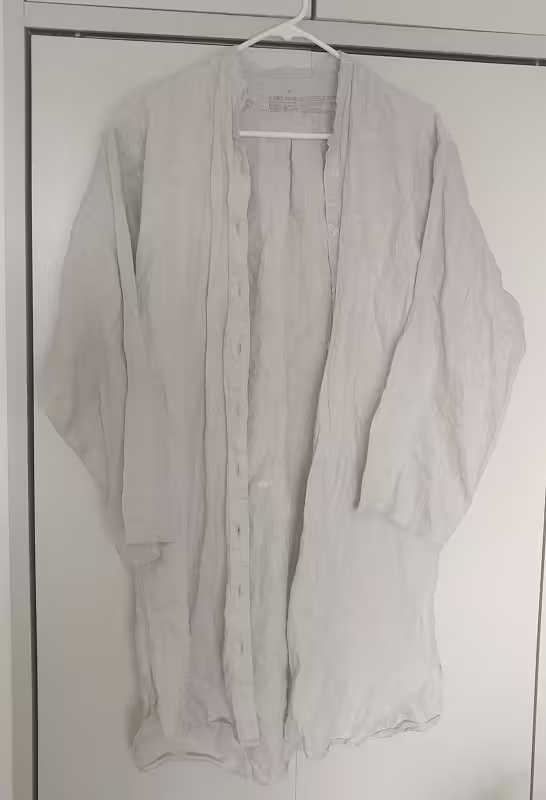 muji long shirt 100% linen・$10・3 hours of work・A thrifted women's shirt, elongated sleeves and removed chest pocket. Repurposed the grey linen from the sacrificial hanten. The side slash pockets are great.
muji long shirt 100% linen・$10・3 hours of work・A thrifted women's shirt, elongated sleeves and removed chest pocket. Repurposed the grey linen from the sacrificial hanten. The side slash pockets are great.
 vanilla hanten 1.5m 10oz 45/55% linen cotton・$7・5 hours of work・This one was fast. An identical copy of brown 2. Might experiment with pockets depending on how the short version goes. 2/6/2021
vanilla hanten 1.5m 10oz 45/55% linen cotton・$7・5 hours of work・This one was fast. An identical copy of brown 2. Might experiment with pockets depending on how the short version goes. 2/6/2021
 buttpack 2m 12oz cotton・$9・~7 hours of work/Based off Russian Partizan harness buttpacks. Really liked the angled side pouches and wanted something that can comfortably hold both water bottles and groceries in the summer. Not quite big enough to cover full-size notebooks. 2/9/2021 Added hardware 2/11/2021
buttpack 2m 12oz cotton・$9・~7 hours of work/Based off Russian Partizan harness buttpacks. Really liked the angled side pouches and wanted something that can comfortably hold both water bottles and groceries in the summer. Not quite big enough to cover full-size notebooks. 2/9/2021 Added hardware 2/11/2021
 harness 1.5m 12oz cotton・$6・Based off British PLCE harnesses and Crye Precision magazine pouches. Zippered compartment in the back. Pouches sized for 2 quart water bottles. 2/9/2021
harness 1.5m 12oz cotton・$6・Based off British PLCE harnesses and Crye Precision magazine pouches. Zippered compartment in the back. Pouches sized for 2 quart water bottles. 2/9/2021
 vanilla short 1.5m 8oz 45/55% linen cotton・$7・~8 hours of work・A cropped version for layering. Experimenting with pockets. 2/6/2021 finished 9?/2021
vanilla short 1.5m 8oz 45/55% linen cotton・$7・~8 hours of work・A cropped version for layering. Experimenting with pockets. 2/6/2021 finished 9?/2021

 oversized blazer 1.5m 8oz 45/55% linen cotton・$10・10 hours of work/Based off Edwina Horl blazers. Deciding on lapel size and overall length. Aim is to make it look very casual, very unsuitlike. 3/5/2021
oversized blazer 1.5m 8oz 45/55% linen cotton・$10・10 hours of work/Based off Edwina Horl blazers. Deciding on lapel size and overall length. Aim is to make it look very casual, very unsuitlike. 3/5/2021
 anorak 2m 10oz 100% cotton・$10・based on the US cold weather mountain parka 7/2/2021 I haven't finished the pockets so anyone can effortlessly play with my nipples
anorak 2m 10oz 100% cotton・$10・based on the US cold weather mountain parka 7/2/2021 I haven't finished the pockets so anyone can effortlessly play with my nipples

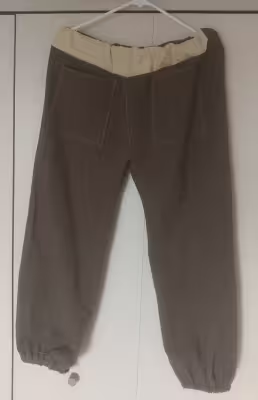 1.5m 10oz 45/55 linen cotton・$5 8/18/2021
1.5m 10oz 45/55 linen cotton・$5 8/18/2021
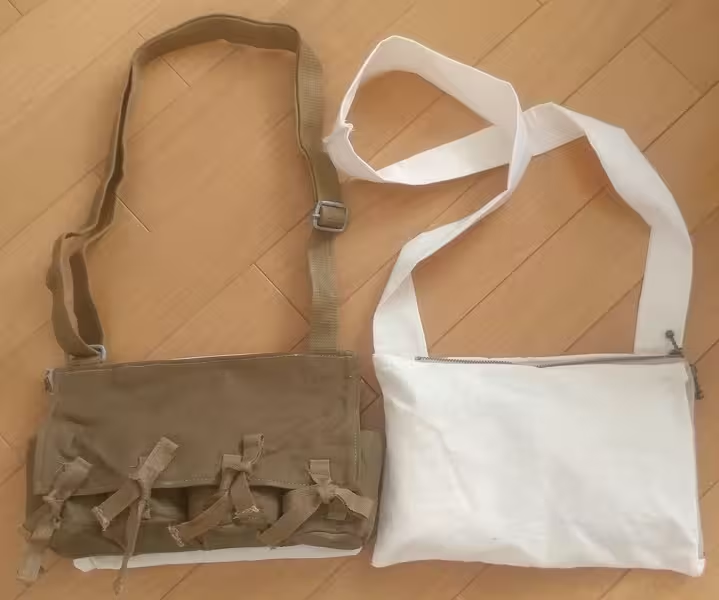 chinese grenade pouch/double zip igiboso added a secondary pocket to the grenade pouch, made a second igiboso with two zipper closure this time. 3/7/2021
chinese grenade pouch/double zip igiboso added a secondary pocket to the grenade pouch, made a second igiboso with two zipper closure this time. 3/7/2021
 bucket hat x2 cotton + 50/50 rayon linen・$5・8 hours of work・Based off of a Panamaka, one step closer to my shamil basayev cosplay 2/27/2022
bucket hat x2 cotton + 50/50 rayon linen・$5・8 hours of work・Based off of a Panamaka, one step closer to my shamil basayev cosplay 2/27/2022

 Waistpack made from an old shirt. for when I horribly maim myself. trauma shears, 4" Israeli bandage, compressed gauze 3/2022
Waistpack made from an old shirt. for when I horribly maim myself. trauma shears, 4" Israeli bandage, compressed gauze 3/2022
 vanilla3 2m 8oz 25/75 linen cotton・$10・unfinished because i'm a thirsty little flower 2/27/2022
vanilla3 2m 8oz 25/75 linen cotton・$10・unfinished because i'm a thirsty little flower 2/27/2022
 belted anorak 2m 10oz 100% cotton・$10・still need to hem and add buttons and buckles 5/7/2022
belted anorak 2m 10oz 100% cotton・$10・still need to hem and add buttons and buckles 5/7/2022
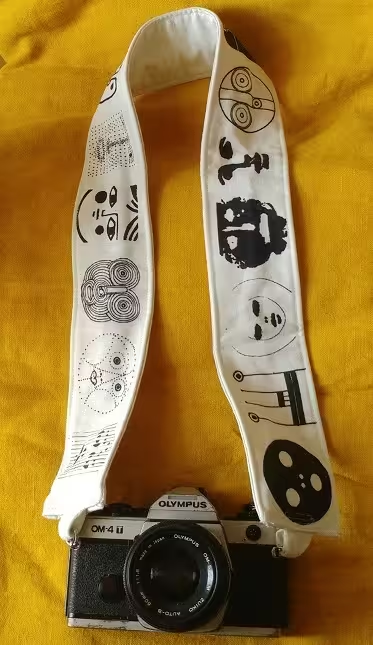 linen camera strap, print from Bruno Munari's Art as Design
linen camera strap, print from Bruno Munari's Art as Design
 another one of these brbrbrbr 9/11/2023
another one of these brbrbrbr 9/11/2023
 barbour longshoreman clone 11/2023
barbour longshoreman clone 11/2023

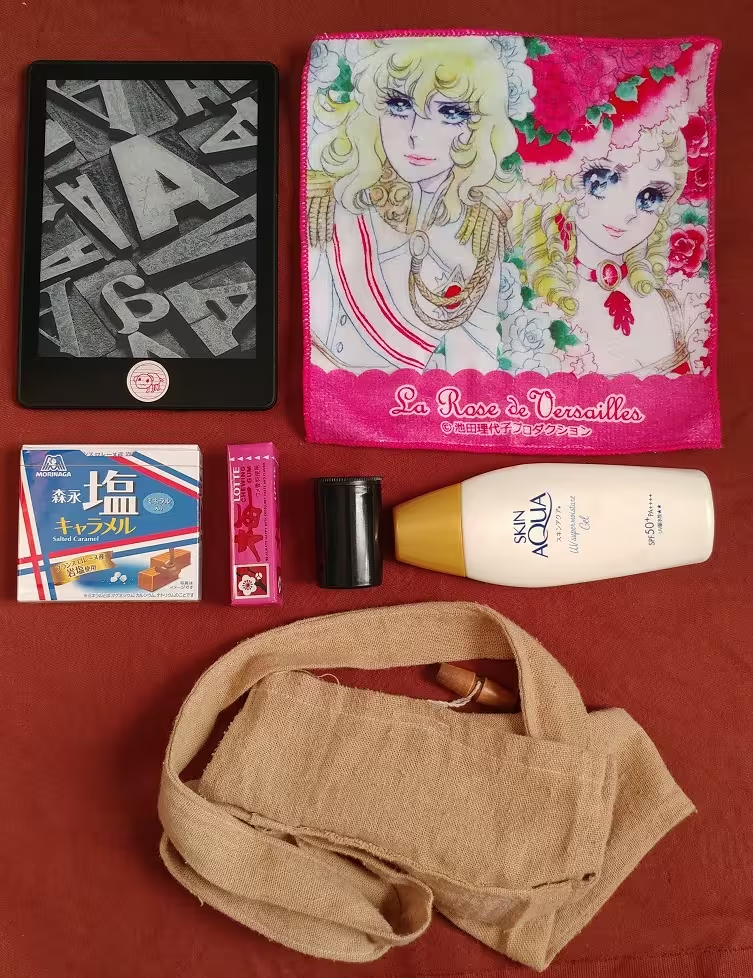 toggle bag 12/2023
toggle bag 12/2023
 it's got pockets wow 3/2024
it's got pockets wow 3/2024
 kimono x4 yeah 2/2024
ε=ε=(っ* ´□` )っ back to top ⤴
kimono x4 yeah 2/2024
ε=ε=(っ* ´□` )っ back to top ⤴
